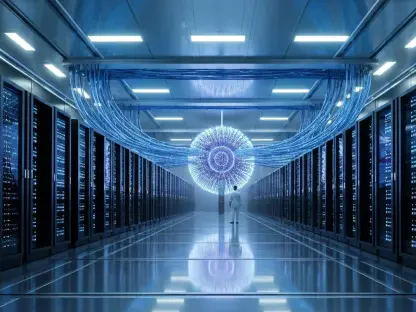Listen to the Article
… the stack you’ll rarely see
The digital economy runs on hidden infrastructures—server rooms in the basement of a skyscraper, microprocessors embedded in phones and thermostats. You rarely see these infrastructures, yet they power daily lives. The stack connects, stores memories, runs businesses, and even entertains. Unlike a luxury hotel lobby or a sleek smartphone, there is no direct sensory satisfaction attached to a data center. But its environmental footprint is tangible and growing.
In 2023, the digital sector consumed about 581 TWh of electricity—roughly 2.1% of global electricity—and produced 0.8% of global energy‑related emissions, according to the International Telecommunication Union (ITU) and the World Benchmarking Alliance. As artificial intelligence (AI) and cloud services proliferate, these numbers are rising fast: data‑center electricity use increased 12% per year from 2017 to 2023.
For business‑to‑business technology leaders, sustainability is no longer an optional virtue signalling exercise. Environmental stewardship is becoming a competitive imperative. Clients and regulators want proof that providers are minimizing the carbon cost of digital services. Investors favor companies that proactively decarbonize their operations. And employees—especially engineers and designers—want to know that their work contributes to a sustainable future. Greening your stack means rethinking architecture, operations, procurement, and culture.
Inside, you’ll explore the hidden anatomy of tech infrastructure, the scale of its environmental impact, and practical steps organizations can take to make sustainability part of their stack’s DNA.
Greening the Backbone: Why it Matters
Digital infrastructures might seem clean: there is no tailpipe, smokestack, or pile of waste visible from the office window. Yet the carbon footprint is substantial. The ITU report notes that electricity demand by digital companies grew at double‑digit rates even while they improved efficiency. The Uptime Institute’s 2025 global data center survey paints a sobering picture: organizations’ metrics on virtualization, renewable‑energy use, power usage effectiveness (PUE), and carbon emissions have stagnated or declined. With AI models requiring enormous computational power and training data, energy consumption is projected to accelerate. Deloitte predicts that data centers will account for roughly 2% of global electricity consumption in 2025 (around 536 TWh) and could double to 1,065 TWh by 2030.
Digital infrastructure is more than a monolithic block of servers. To reduce its carbon intensity, you must understand what consumes energy. Deloitte’s analysis breaks down the energy use of a typical data center: servers and computing resources consume about 40% of energy, cooling systems about 38–40%, internal power conditioning 8–10%, network equipment 5%, storage 5% and lighting 1–2%.
These numbers highlight that efficiency gains in hardware and cooling will be essential; one cannot focus solely on renewable procurement.
The Carbon Toll of AI and the Cloud
AI and cloud have become ubiquitous. Organizations treat machine‑learning predictions as utilities and subscribe to cloud platforms for elasticity. Yet, the cloud’s convenience masks an energy cost. A 2025 infographic from Visual Capitalist estimates that U.S. data centers could consume nearly 12% of U.S. electricity by 2030, up from about 4% in 2023. The surge is driven by AI training and inference workloads, streaming services, and the exponential growth of data. This expansion means that digital footprints are not only about the carbon emissions from operating servers but also about resource extraction for manufacturing chips and batteries, cooling water use, and end‑of‑life waste.
The Uptime Institute survey underscores the challenge: only 27% of organizations track water usage for cooling, down from 43% the previous year, and only 26% measure scope 2 emissions (those associated with purchased electricity). When metrics aren’t measured, they can’t be managed. Meanwhile, AI training runs often use hundreds of GPUs. If each accelerator consumes over 1 kW, training for weeks or months translates into enormous power demand. As an example of the hidden impact, in 2024, Google researchers estimated that training GPT‑3 generated about 550 t of CO₂; newer models are larger still.
Without detailed measurement and accountability, organizations risk misjudging their digital sustainability.
Best Practices: Building a Greener Stack
So, how can a technology organization transform these insights into action? The following best practices draw from the OxygenIT guide and industry reports:
Right‑size and optimize workloads. Use autoscaling and load balancing to adjust compute resources to demand.
De‑provision idle resources. Routinely identify and shut down dormant compute instances, unused volumes, and zombie containers.
Select low‑carbon regions and providers. Evaluate data‑center location based on grid‑emission intensity and water stress.
Extend equipment lifetimes and embrace circularity. Design procurement policies that prolong hardware use. Use refurbished or modular systems that allow component upgrades.
Improve cooling and track PUE. Invest in efficient cooling solutions, such as liquid or geothermal cooling. Monitor PUE regularly and set improvement targets.
Implement carbon accounting. Adopt cloud carbon‑footprint tools that calculate emissions based on region, instance type, and usage patterns.
Educate and empower teams. Create internal resources, such as Xero’s carbon calculator, to help developers understand the footprint of their code.
Set public targets and report progress. Commit to science‑based targets for scope 1, 2, and 3 emissions. Report progress transparently. Public disclosure fosters accountability and facilitates benchmarking.
Lessons From Leading Companies
Several technology giants are demonstrating ambition and transparency:
Microsoft. The firm aims to be carbon negative by 2030 and to match 100% of its energy consumption with renewable energy by 2025. Its 2025 sustainability report highlights a 30% reduction in scope 1 and 2 emissions from its 2020 base year, though scope three emissions account for over 97% of total emissions. Microsoft invested in renewable projects worldwide, increasing contracted capacity from 1.8 GW to 34 GW and diverting over 2,500 metric tons of packaging from 30,000 server racks for recycling. It also launched a new program requiring photovoltaic panels in power‑purchase agreements to be reused or recycled.
Google. In 2023, Google announced plans to operate on 24/7 carbon‑free energy by 2030, matching consumption with carbon‑free generation every hour. This means investing in time‑matched renewable energy rather than annual offsets. Google uses advanced modelling to select data‑center locations where renewable power is abundant and invests in battery storage.
Meta (Facebook). Meta has achieved net‑zero emissions for its operations since 2020 and runs on 100% renewable energy. The company invests in water restoration projects to offset its data‑center water consumption and is experimenting with ambient air cooling and heat recovery for neighboring communities.
Xero. Though smaller, Xero’s example is instructive because it emphasizes measurement and developer empowerment. Recognizing that scope three emissions dominated its footprint, Xero developed an internal carbon calculator to measure per‑transaction emissions and set ambitious reduction goals. This tool helps engineers make design choices that minimize emissions.
These pioneers show that ambition must be backed by action and transparency. They also highlight that scope three emissions dwarf direct operational emissions. Achieving net‑zero or carbon‑negative status requires deep collaboration across the value chain.
Culture and Collaboration: Empowering People
Technology infrastructure is built and maintained by people. Without cultural change, even the best technology will not deliver sustainability. Empowering developers and operations teams is vital. Provide them with tools and training to understand the energy and carbon implications of their work. Xero’s internal carbon calculator is a good example. Establish green champions within engineering teams to advocate for sustainable practices. Recognize and reward sustainability achievements just as you would cost savings or performance improvements.
Collaboration extends beyond internal teams. Engage suppliers to adopt renewable energy and reduce the carbon intensity of hardware and services. Collaborate with customers to encourage efficient use of your platforms, share best practices, and jointly develop sustainability features. Industry alliances such as the Green Software Foundation and the Open Compute Project provide frameworks for sharing knowledge and driving standards.
A Competitive Advantage Hiding in the Shadows
Adopting a green stack is not merely about avoiding negative publicity or complying with regulations. It is an opportunity for differentiation and innovation. Many procurement contracts now include emissions thresholds. Customers increasingly ask providers to disclose the carbon footprint of digital services. Investors look for companies that can grow while decarbonizing. Employees want to build products that contribute to a sustainable future. By investing in renewable energy, improving efficiency, embracing circularity, and empowering teams, organizations can turn sustainability into a competitive advantage.
The journey will not be easy.
It requires transparency, investment, and cultural change. But the path is clear. The digital economy is shaping the future; it is up to you to ensure it remains grounded in planetary health. Greening your stack means imagining a world where computational power and ecological stewardship go hand‑in‑hand. The unseen engines that drive digital lives can be both powerful and sustainable—if you make the commitment today.









